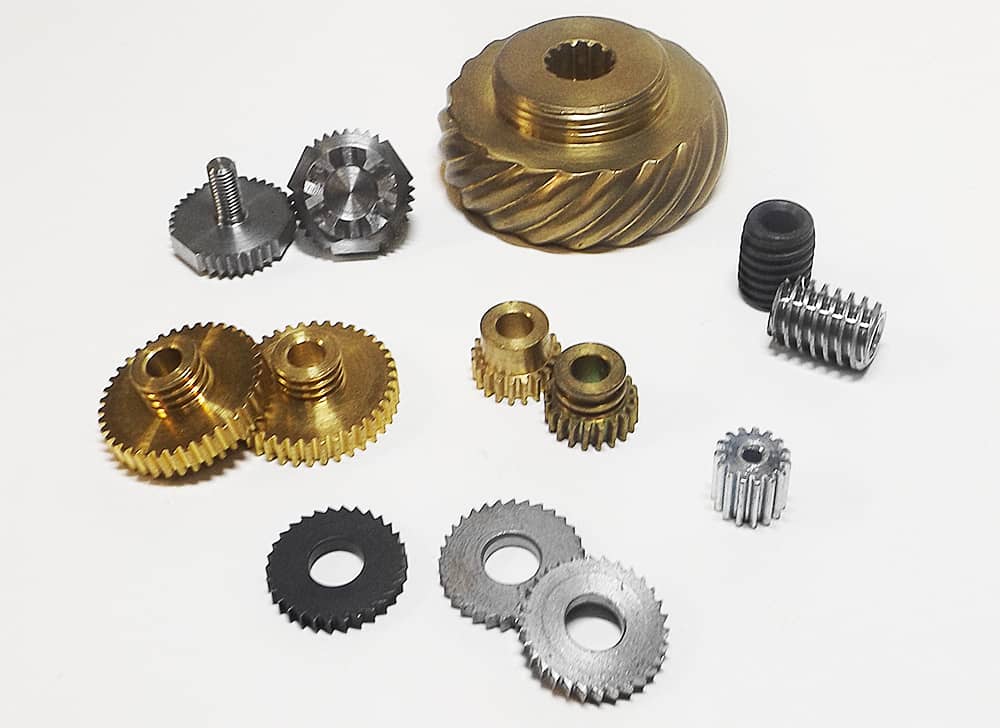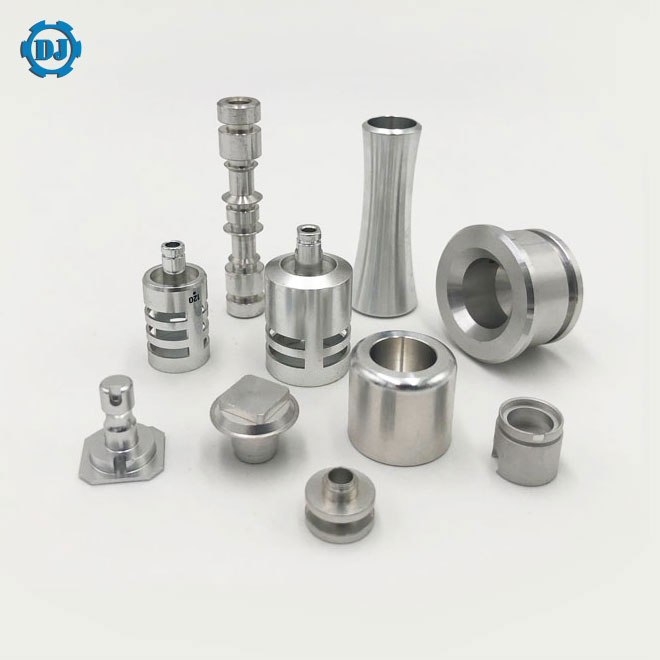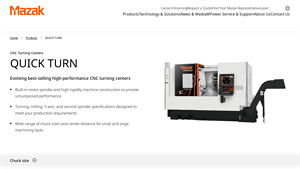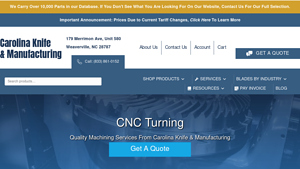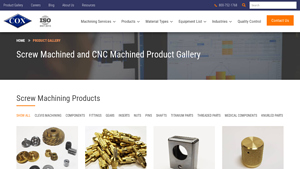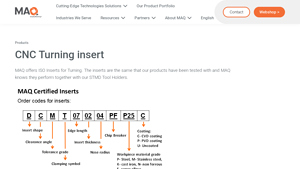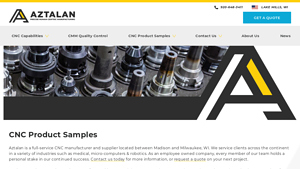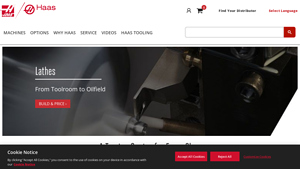Cnc Turning Products Guide: Type, Cost, Top List…
Introduction: Navigating the Global Market for cnc turning products
In an increasingly competitive landscape, sourcing high-quality CNC turning products presents a formidable challenge for international B2B buyers. As industries across Africa, South America, the Middle East, and Europe evolve, the demand for precision-engineered components—ranging from aerospace parts to medical devices—grows exponentially. This guide delves into the complexities of navigating the global market for CNC turning products, offering valuable insights into the various types available, their applications, and the critical factors involved in supplier vetting and cost assessment.
Understanding the nuances of CNC turning is essential for informed purchasing decisions. From selecting the right materials—such as brass, aluminum, or stainless steel—to evaluating the manufacturing capabilities of potential suppliers, every step requires careful consideration. This comprehensive resource equips buyers with the knowledge necessary to identify the best-fit suppliers, ensuring reliability and quality in their supply chains.
Moreover, as businesses in regions like Nigeria and Germany look to enhance their operational efficiencies, leveraging insights from this guide will empower them to make strategic choices. By addressing the key challenges faced in sourcing CNC turning products, this guide not only streamlines the procurement process but also fosters partnerships that drive innovation and success in a global marketplace.
Understanding cnc turning products Types and Variations
| Type Name | Key Distinguishing Features | Primary B2B Applications | Brief Pros & Cons for Buyers |
|---|---|---|---|
| CNC Brass Parts | High corrosion resistance, excellent machinability | Electronics, Automotive, Medical devices | Pros: Good conductivity; Cons: Higher cost than aluminum |
| CNC Aluminum Parts | Lightweight, high strength-to-weight ratio | Aerospace, Automotive, Consumer products | Pros: Cost-effective; Cons: Prone to scratching |
| CNC Stainless Steel Parts | Exceptional strength, durability, and resistance to rust | Medical equipment, Aerospace, Military applications | Pros: Long lifespan; Cons: More expensive than brass |
| CNC Plastic Parts | Versatile material options, lightweight | Electronics, Medical devices, Consumer goods | Pros: Low weight; Cons: Limited temperature resistance |
| CNC Precision Turned Parts | Tight tolerances (0.001mm-0.005mm), customizable designs | Aerospace, Automotive, Industrial machinery | Pros: High precision; Cons: Longer lead times |
What Are the Characteristics of CNC Brass Parts and Their Applications?
CNC brass parts are known for their excellent machinability and corrosion resistance, making them ideal for applications in electronics, automotive components, and medical devices. Their ability to conduct electricity efficiently also makes them a preferred choice for electrical connectors and components. When purchasing, buyers should consider the specific requirements of their applications, such as conductivity needs and budget constraints, as brass can be more expensive than alternatives like aluminum.
How Do CNC Aluminum Parts Stand Out in Various Industries?
CNC aluminum parts offer a high strength-to-weight ratio, making them particularly suitable for industries like aerospace and automotive, where reducing weight is crucial. They are also cost-effective compared to other metals, allowing for large-scale production without significantly impacting budgets. However, potential buyers should be aware that aluminum parts can be prone to scratching and may require additional surface treatments to enhance durability.
Why Are CNC Stainless Steel Parts Preferred for Critical Applications?
CNC stainless steel parts are renowned for their strength, durability, and resistance to rust and corrosion, making them indispensable in the medical, aerospace, and military sectors. Their ability to maintain integrity under extreme conditions ensures a long lifespan, which can justify their higher initial cost. Buyers should evaluate their specific application needs, including environmental conditions and regulatory compliance, to determine if stainless steel is the right choice.
What Makes CNC Plastic Parts a Versatile Choice for Manufacturers?
CNC plastic parts are lightweight and can be produced from various materials, such as PVC and nylon, making them suitable for diverse applications, including electronics and medical devices. They are often less expensive than metal counterparts and can be customized easily. However, buyers should consider the limitations of plastic in terms of temperature resistance and mechanical strength, especially for high-stress applications.
How Do CNC Precision Turned Parts Meet Industry Standards?
CNC precision turned parts are characterized by their tight tolerances, typically ranging from 0.001mm to 0.005mm, making them essential for industries requiring high accuracy, such as aerospace and industrial machinery. These parts can be customized to meet specific design requirements, enhancing their applicability across various sectors. Buyers should assess their precision needs and lead time, as the production of highly precise components can sometimes result in longer manufacturing processes.
Key Industrial Applications of cnc turning products
| Industry/Sector | Specific Application of CNC Turning Products | Value/Benefit for the Business | Key Sourcing Considerations for this Application |
|---|---|---|---|
| Aerospace | Precision components for aircraft engines | High reliability and safety standards | Compliance with aerospace regulations and certifications |
| Automotive | Engine and transmission parts | Enhanced performance and reduced weight | Material quality and precision machining capabilities |
| Medical Devices | Surgical instruments and implants | Biocompatibility and precision engineering | Certifications like ISO 13485 for medical manufacturing |
| Electronics | Connectors and housings | Improved durability and functionality | Customization options and rapid prototyping capabilities |
| Military and Defense | Tactical equipment components | Robustness under extreme conditions | Stringent quality control and rapid delivery timelines |
How Are CNC Turning Products Used in Aerospace Applications?
In the aerospace sector, CNC turning products are essential for manufacturing precision components used in aircraft engines and structural parts. These components must meet rigorous safety and performance standards, necessitating high tolerances and material integrity. International buyers, particularly from Europe and the Middle East, must ensure that suppliers comply with aerospace regulations and certifications, such as AS9100, to mitigate risks associated with component failure.
What Role Do CNC Turning Products Play in the Automotive Industry?
CNC turning products are integral to the automotive industry for producing engine and transmission parts. These components benefit from CNC technology’s ability to create lightweight yet strong parts, improving fuel efficiency and vehicle performance. Buyers from regions like Africa and South America should prioritize suppliers with advanced machining capabilities and proven track records in producing high-quality automotive components, ensuring compliance with industry standards such as IATF 16949.
How Are CNC Turning Products Utilized in Medical Device Manufacturing?
In medical device manufacturing, CNC turning products are critical for producing surgical instruments and implants that require biocompatibility and precision engineering. These products must adhere to strict regulations, including ISO 13485, to ensure patient safety. B2B buyers, particularly in Europe, should focus on sourcing from manufacturers who can provide traceability and quality assurance documentation, as these factors are essential for regulatory compliance.
What Are the Applications of CNC Turning Products in Electronics?
CNC turning products are widely used in the electronics industry for creating connectors, housings, and other components that require high durability and functionality. The precision offered by CNC machining helps in minimizing defects, thus enhancing product reliability. Buyers from Africa and South America should seek suppliers that offer customization options and rapid prototyping services to meet the fast-paced demands of the electronics market.
How Do CNC Turning Products Support Military and Defense Operations?
In the military and defense sectors, CNC turning products are used to manufacture components for tactical equipment that must withstand extreme conditions. The robustness and precision of these parts are crucial for operational effectiveness. Buyers from the Middle East and Europe need to ensure that their suppliers adhere to stringent quality control measures and can meet rapid delivery timelines, as these factors are vital for maintaining operational readiness.
3 Common User Pain Points for ‘cnc turning products’ & Their Solutions
Scenario 1: Difficulty in Ensuring Precision Tolerances in CNC Turning
The Problem:
B2B buyers often face challenges in maintaining the precision tolerances required for their CNC turned products. Industries such as aerospace, automotive, and medical devices rely heavily on high-precision components, where even minor deviations can lead to significant operational failures or safety hazards. Buyers may struggle with suppliers who either cannot meet tight tolerances or fail to deliver consistent quality across batches, leading to delays, increased costs, and potential liability issues.
The Solution:
To ensure the required precision tolerances, it’s crucial for buyers to engage with suppliers who specialize in high-precision CNC turning products. Before placing an order, buyers should request detailed documentation of the supplier’s capabilities, including their machining processes, quality control measures, and previous work examples. It’s beneficial to establish a clear communication channel with the supplier to discuss specific tolerance requirements upfront. Additionally, implementing a pilot run or small batch order can help assess the supplier’s ability to meet precision specifications before committing to larger orders. Buyers should also consider suppliers that utilize advanced CNC technology, such as multi-axis machining centers, which can enhance precision and efficiency.
Scenario 2: Long Lead Times Affecting Production Schedules
The Problem:
Many B2B buyers experience frustration with long lead times for CNC turning products, which can disrupt their production schedules. This issue is particularly prevalent in industries where time-sensitive components are critical, such as in electronics or automotive sectors. Delays in receiving CNC turned parts can result in halted production lines, increased costs, and missed market opportunities, ultimately impacting a company’s competitiveness.
The Solution:
To mitigate long lead times, buyers should prioritize establishing relationships with suppliers that offer flexible manufacturing capabilities and stock management. When sourcing CNC turning products, look for suppliers who maintain an inventory of commonly used parts or who can quickly pivot their production schedules to accommodate urgent requests. It’s also advisable to discuss potential lead time reductions during the initial negotiation phase. Buyers can benefit from employing just-in-time (JIT) inventory management practices, which allow for better synchronization of part deliveries with production schedules. Leveraging local suppliers can also significantly reduce shipping times and customs delays, enhancing overall responsiveness.
Scenario 3: Challenges in Material Selection and Compatibility
The Problem:
Selecting the right materials for CNC turning products can be a daunting task for B2B buyers. Different applications require specific material properties, such as strength, corrosion resistance, or weight considerations. Buyers may struggle with understanding the nuances between materials like aluminum, stainless steel, brass, and plastic, which can lead to suboptimal product performance or failures.
The Solution:
To navigate material selection effectively, buyers should engage in thorough research and consultation with their suppliers. It’s essential to communicate the specific application requirements clearly, including environmental conditions and performance expectations. Suppliers should provide guidance on material properties and recommend the best options based on the intended use of the turned parts. Additionally, buyers can benefit from requesting samples or prototypes to assess the material’s performance in real-world conditions before making large-scale orders. Collaborating with suppliers who offer comprehensive material certifications and testing results can also help ensure that selected materials meet industry standards and regulations, ultimately leading to better product outcomes.
Strategic Material Selection Guide for cnc turning products
What Are the Key Properties of Common Materials Used in CNC Turning Products?
CNC turning products are manufactured from various materials, each offering distinct properties that influence performance, durability, and application suitability. Understanding these materials is crucial for international B2B buyers seeking to optimize their product offerings.
Aluminum: A Lightweight and Versatile Option
Aluminum is widely recognized for its excellent strength-to-weight ratio, making it an ideal choice for applications where weight savings are critical, such as in aerospace and automotive industries. It exhibits good corrosion resistance, particularly when anodized, and has a high thermal and electrical conductivity.
Pros: Aluminum is relatively easy to machine, allowing for complex designs with tight tolerances. It is also cost-effective, particularly for large production runs.
Cons: While durable, aluminum can be less resistant to wear compared to harder materials like steel. It may also deform under high temperatures or pressures, limiting its use in high-stress applications.
Impact on Application: Aluminum is compatible with various media, including air and water, but may not be suitable for aggressive chemicals without proper surface treatment.
Considerations for International Buyers: Buyers from regions such as Europe and the Middle East should ensure compliance with standards like DIN and ASTM for material quality and performance.
Stainless Steel: Strength and Corrosion Resistance
Stainless steel is renowned for its exceptional strength and resistance to corrosion, making it suitable for applications in harsh environments, such as medical devices and marine components. It maintains its integrity at high temperatures and pressures.
Pros: Stainless steel offers excellent durability and longevity, making it a preferred choice for critical applications. It can also be polished to achieve a high aesthetic finish.
Cons: The material can be more challenging to machine than aluminum, leading to higher manufacturing costs. Additionally, its density makes it heavier, which may not be ideal for all applications.
Impact on Application: Stainless steel is compatible with a wide range of media, including corrosive substances, making it ideal for chemical processing applications.
Considerations for International Buyers: Buyers should be aware of the specific grades of stainless steel (e.g., 304, 316) that meet their application requirements and comply with international standards like ASTM and JIS.
Brass: A Reliable Choice for Precision Components
Brass, an alloy of copper and zinc, is frequently used in CNC turning for its excellent machinability and aesthetic appeal. It is often employed in applications requiring precision fittings and electrical components due to its good conductivity.
Pros: Brass is easy to machine, allowing for intricate designs and tight tolerances. It also exhibits good corrosion resistance, particularly in non-aggressive environments.
Cons: Brass is less durable than stainless steel and may not withstand high-stress applications. It can also tarnish over time, affecting its appearance.
Impact on Application: Brass is suitable for applications involving low-pressure water systems and electrical connectors but should be avoided in high-temperature or high-pressure environments.
Considerations for International Buyers: Buyers should ensure that the brass used complies with local standards and regulations, particularly in the electrical and plumbing sectors.
Plastic: Lightweight and Cost-Effective
CNC machining of plastics, such as PVC and POM, offers a lightweight alternative for various applications, including consumer goods and automotive components. Plastics can be engineered to provide specific properties, such as enhanced chemical resistance.
Pros: Plastics are generally less expensive to produce and can be machined quickly. They also offer excellent resistance to corrosion and chemicals, making them suitable for diverse applications.
Cons: While lightweight, plastics may not offer the same strength or durability as metals. They can also be sensitive to temperature changes, leading to deformation in high-heat environments.
Impact on Application: Plastics are ideal for applications where weight savings are essential, but their media compatibility should be evaluated carefully to avoid degradation.
Considerations for International Buyers: Buyers should verify that plastics meet relevant international standards for safety and performance, particularly in regulated industries.
Summary Table of Material Selection for CNC Turning Products
| Material | Typical Use Case for cnc turning products | Key Advantage | Key Disadvantage/Limitation | Relative Cost (Low/Med/High) |
|---|---|---|---|---|
| Aluminum | Aerospace components, automotive parts | Lightweight and easy to machine | Less wear-resistant than harder materials | Low |
| Stainless Steel | Medical devices, marine applications | Excellent strength and corrosion resistance | More challenging to machine | High |
| Brass | Precision fittings, electrical components | Good machinability and aesthetic appeal | Less durable than stainless steel | Medium |
| Plastic | Consumer goods, automotive components | Cost-effective and lightweight | Lower strength and heat resistance | Low |
This strategic material selection guide provides B2B buyers with critical insights into the properties, advantages, and limitations of common materials used in CNC turning products, enabling informed decision-making tailored to their specific needs.
In-depth Look: Manufacturing Processes and Quality Assurance for cnc turning products
What Are the Main Stages of Manufacturing CNC Turning Products?
CNC turning is a precise machining process that transforms raw materials into finished parts through a series of well-defined stages. Understanding these stages is essential for B2B buyers looking to ensure the quality and reliability of their products.
Material Preparation
The manufacturing process begins with material selection, where buyers can choose from a variety of metals and plastics, such as aluminum, brass, stainless steel, and engineering plastics like POM and PVC. Each material has unique properties that influence the final product’s performance. After selecting the appropriate material, it is cut into manageable lengths or shapes before being loaded into the CNC lathe.
Forming and Machining
The core of CNC turning involves the use of CNC lathes, which rotate the workpiece against a cutting tool. This automated process allows for high precision and repeatability, making it ideal for producing complex shapes and tight tolerances, often as fine as 0.001mm to 0.005mm. Key techniques include:
- Turning: The primary operation where the material is cut away to create cylindrical shapes.
- Milling: In some setups, milling operations may also be performed to create features such as grooves or flats.
- Drilling and Tapping: Holes can be drilled and threads tapped as part of the process, depending on the product requirements.
The use of advanced CNC programming allows for simultaneous multi-axis machining, increasing efficiency and reducing cycle time.
Assembly
For products that consist of multiple components, assembly may be required after the turning process. This can involve fitting parts together, welding, or adding fasteners. Effective communication with suppliers is crucial at this stage to ensure that all components fit together as designed.
Finishing
Finishing processes enhance the aesthetic and functional qualities of CNC turned products. This stage may include:
- Surface Treatments: Options like anodizing, plating, and polishing improve corrosion resistance and appearance.
- Quality Inspection: Final products undergo rigorous inspection to ensure they meet specified tolerances and surface finish requirements.
How Is Quality Assurance Implemented in CNC Turning?
Quality assurance (QA) is vital in maintaining the integrity of CNC turning products. International buyers must understand the standards and checkpoints that ensure product quality.
Relevant International Standards
B2B buyers should look for suppliers who comply with recognized quality standards. Key certifications include:
- ISO 9001: A globally recognized standard for quality management systems that outlines requirements for consistent quality in products and services.
- CE Marking: Indicates compliance with European health, safety, and environmental protection standards, particularly important for buyers in Europe.
- API Standards: Relevant for buyers in the oil and gas sector, ensuring products meet industry-specific requirements.
What Are the Key QC Checkpoints?
Quality control is typically structured around several key checkpoints throughout the manufacturing process:
- Incoming Quality Control (IQC): Inspects raw materials upon arrival to ensure they meet specified requirements before production begins.
- In-Process Quality Control (IPQC): Continuous monitoring during the machining process to detect any deviations in real time. This includes checking dimensions and surface finishes at various stages of production.
- Final Quality Control (FQC): A comprehensive inspection of finished products to verify they conform to specifications, including functionality and aesthetic quality.
What Testing Methods Are Common in CNC Turning?
To assure quality, various testing methods can be employed:
- Dimensional Inspection: Using calipers and micrometers to verify that parts meet specified tolerances.
- Surface Roughness Testing: Ensures that the surface finish meets aesthetic and functional criteria.
- Material Testing: Includes hardness tests, tensile tests, and metallurgical analysis to confirm material properties.
How Can B2B Buyers Verify Supplier Quality Control?
Buyers must take proactive steps to ensure their suppliers adhere to stringent quality standards. Here are some actionable strategies:
- Supplier Audits: Conducting regular audits of suppliers can help verify compliance with quality standards and assess their manufacturing processes.
- Requesting Quality Reports: Suppliers should provide documentation detailing their quality control processes and results from inspections and tests.
- Third-Party Inspections: Engaging independent third-party inspectors can provide an unbiased assessment of product quality before shipment.
What Are the QC and Certification Nuances for International Buyers?
International buyers must be aware of specific nuances when dealing with suppliers across different regions:
- Cultural and Regulatory Differences: Understanding local manufacturing practices and regulatory requirements is essential. For instance, buyers from Africa may encounter different standards compared to those in Europe.
- Documentation: Ensure that suppliers provide all necessary documentation, including certificates of compliance and inspection reports, which may vary by region.
- Supply Chain Transparency: Building relationships with suppliers that prioritize transparency can mitigate risks associated with quality control.
Conclusion
The manufacturing processes and quality assurance measures for CNC turning products are intricate and essential for delivering high-quality components. By understanding these processes and the associated quality control standards, B2B buyers can make informed decisions, ensuring that their partnerships yield reliable and durable products that meet their specific industry requirements.
Practical Sourcing Guide: A Step-by-Step Checklist for ‘cnc turning products’
Introduction
This guide serves as a practical checklist for B2B buyers aiming to procure CNC turning products effectively. The CNC turning process is pivotal in various industries, including aerospace, automotive, and electronics. By following these steps, you can ensure that your sourcing process is thorough, efficient, and tailored to your specific needs.
Step 1: Define Your Technical Specifications
Before initiating any sourcing activities, it is vital to establish clear technical specifications for the CNC turning products you need. This includes defining dimensions, tolerances, materials, and surface treatments. Why? A well-defined specification not only streamlines communication with suppliers but also minimizes the risk of receiving substandard products that do not meet your operational requirements.
- Key Considerations:
- Specify the types of materials (e.g., aluminum, brass, stainless steel).
- Outline the required tolerances (e.g., 0.001mm – 0.005mm).
Step 2: Research Potential Suppliers
Conduct thorough research to identify potential suppliers who specialize in CNC turning products. Look for manufacturers with a proven track record in your industry and positive customer feedback. Why? This step is essential to ensure that you partner with reliable suppliers who can meet your quality and delivery expectations.
- Where to Look:
- Online B2B marketplaces (e.g., Alibaba, ThomasNet).
- Industry-specific trade shows and exhibitions.
Step 3: Evaluate Supplier Capabilities
Assess the capabilities of shortlisted suppliers to determine if they can meet your technical specifications and production volumes. Request detailed information about their machinery, quality control processes, and production capacity. Why? Understanding a supplier’s capabilities allows you to gauge whether they can deliver your order on time and to the required standards.
- Important Aspects:
- Verify the types of CNC machines they use (e.g., high-speed turning centers).
- Inquire about their quality assurance measures (e.g., certifications like ISO 9001).
Step 4: Request Quotes and Compare Pricing
Once you have identified potential suppliers, request detailed quotes that outline pricing, lead times, and payment terms. Compare these quotes not just on price but also on the value offered, including quality, service, and reliability. Why? This enables you to make informed decisions that balance cost and quality, ensuring that you receive the best overall value.
- What to Include in Quotes:
- Breakdown of costs (material, labor, shipping).
- Lead times for production and delivery.
Step 5: Verify Supplier Certifications
Ensure that your chosen suppliers possess the necessary certifications that demonstrate their compliance with industry standards. Certifications such as ISO 9001 or specific industry-related certifications are indicators of a supplier’s commitment to quality. Why? This verification mitigates risks associated with product quality and compliance, safeguarding your business against potential issues.
- How to Verify:
- Request copies of certificates.
- Check for any industry-specific compliance requirements.
Step 6: Conduct a Site Visit or Audit
If possible, arrange a site visit or audit of the supplier’s facility. This allows you to assess their production processes, equipment, and quality control measures firsthand. Why? A physical inspection provides deeper insights into the supplier’s operations, helping you to ensure they meet your standards before placing large orders.
- Focus Areas During Visits:
- Cleanliness and organization of the production area.
- Availability of quality control documentation.
Step 7: Establish Clear Communication Channels
Finally, establish effective communication channels with your selected supplier. Ensure that there are designated points of contact for both parties, facilitating smooth information exchange regarding orders, updates, and any potential issues. Why? Open lines of communication are crucial for addressing concerns promptly and maintaining a strong supplier relationship.
- Best Practices:
- Use project management tools for tracking progress.
- Schedule regular check-ins to discuss ongoing projects.
By following this checklist, B2B buyers can navigate the complexities of sourcing CNC turning products with confidence, ensuring that they secure high-quality components that meet their operational needs.
Comprehensive Cost and Pricing Analysis for cnc turning products Sourcing
Understanding the cost structure and pricing dynamics of CNC turning products is essential for international B2B buyers seeking to optimize their sourcing strategies. This analysis breaks down the various cost components, price influencers, and offers actionable tips for effective negotiations.
What Are the Key Cost Components in CNC Turning Products?
-
Materials: The choice of materials significantly impacts the overall cost. Common materials like aluminum and stainless steel tend to be more affordable than specialty alloys such as titanium or high-grade brass. Prices fluctuate based on global demand, availability, and quality.
-
Labor: Labor costs vary by region and are influenced by local wage rates and the skill level required for precision machining. Countries with lower labor costs may offer competitive pricing but could compromise on quality if not managed properly.
-
Manufacturing Overhead: This includes costs associated with factory operations, utilities, maintenance, and administrative expenses. Efficient production processes can help mitigate these costs, making it crucial to evaluate the supplier’s operational efficiencies.
-
Tooling: Tooling costs encompass the equipment and machinery required for production. High-precision CNC machines can have substantial upfront costs, but they improve output quality and reduce long-term manufacturing costs.
-
Quality Control (QC): Implementing stringent QC processes ensures that the products meet specified tolerances and standards. While this adds to the cost, it is vital for maintaining quality, especially in industries like aerospace and medical where precision is non-negotiable.
-
Logistics: Shipping and handling costs can vary greatly depending on the destination, shipping method, and Incoterms agreed upon. International shipping can add complexity, making it essential to factor these costs into the total price.
-
Margin: Suppliers typically include a profit margin in their pricing, which can vary based on their positioning in the market, competition, and the perceived value of their products.
What Influences Pricing for CNC Turning Products?
Several factors influence the pricing of CNC turning products, particularly for international B2B transactions:
-
Volume/MOQ: Larger orders generally yield lower per-unit costs due to economies of scale. Establishing minimum order quantities (MOQs) can affect pricing strategies and should be negotiated accordingly.
-
Specifications and Customization: Custom designs, complex geometries, and specific tolerances can increase costs. Clear communication of requirements can help in obtaining more accurate quotes.
-
Quality and Certifications: Products that require certifications (like ISO or AS9100) may incur additional costs. Buyers should ensure that the supplier’s certifications align with their industry standards.
-
Supplier Factors: The supplier’s reputation, experience, and operational capacity can influence pricing. Established suppliers may charge a premium for their reliability and quality assurance.
-
Incoterms: The chosen Incoterms (e.g., FOB, CIF) will dictate who is responsible for shipping costs and risks, significantly affecting the total cost.
How Can Buyers Effectively Negotiate Prices for CNC Turning Products?
-
Leverage Total Cost of Ownership (TCO): Rather than focusing solely on unit prices, consider the total cost of ownership, which includes maintenance, quality assurance, and operational efficiencies. This broader perspective can lead to better long-term sourcing decisions.
-
Build Relationships: Establishing a strong relationship with suppliers can lead to better pricing and terms. Long-term partnerships often yield discounts and improved service levels.
-
Request Multiple Quotes: Obtaining quotes from several suppliers can provide insights into market pricing and help identify competitive offers.
-
Be Transparent About Needs: Clearly communicate your requirements and expectations. This transparency can facilitate more accurate pricing and foster trust between parties.
-
Understand Local Market Dynamics: For buyers in regions like Africa or South America, being aware of local market conditions, currency fluctuations, and trade regulations can enhance negotiation leverage.
Conclusion
While prices for CNC turning products can vary widely based on numerous factors, understanding the underlying cost components and price influencers enables international B2B buyers to make informed purchasing decisions. By employing strategic negotiation tactics and focusing on long-term partnerships, buyers can achieve cost efficiencies that benefit their operations. Always remember that pricing is not just about the upfront costs but encompasses the overall value delivered by the supplier.
Alternatives Analysis: Comparing cnc turning products With Other Solutions
Exploring Alternatives to CNC Turning Products
When considering manufacturing processes for precision components, it’s essential to evaluate alternatives to CNC turning products. This analysis focuses on comparing CNC turning with two viable alternatives: traditional manual machining and additive manufacturing (3D printing). Understanding these options will help B2B buyers make informed decisions based on their specific needs.
| Comparison Aspect | CNC Turning Products | Traditional Manual Machining | Additive Manufacturing (3D Printing) |
|---|---|---|---|
| Performance | High precision, repeatable results | Variable precision, depends on operator skill | Good for complex geometries, but may lack precision for some applications |
| Cost | Higher initial investment; cost-effective for large production runs | Lower initial costs; labor-intensive, increasing cost per unit | Lower costs for small runs, but material costs can be high |
| Ease of Implementation | Requires skilled operators and setup time | Straightforward for skilled machinists, but slower | Requires specialized software and training, but setup can be quick |
| Maintenance | Regular maintenance needed for machinery | Minimal, but depends on tool wear | Minimal maintenance for printers; more for post-processing |
| Best Use Case | Mass production of precise parts | Custom, low-volume production | Prototyping and complex, low-volume production |
What are the Advantages and Disadvantages of Traditional Manual Machining?
Traditional manual machining is a conventional method that relies heavily on skilled operators to produce parts. The primary advantage is the lower initial investment in equipment. This method is particularly effective for custom or low-volume production runs where flexibility is essential. However, the downside includes variable precision, which can lead to inconsistencies in part quality. Additionally, as production volume increases, the labor costs can escalate, making it less cost-effective compared to CNC turning for larger runs.
How Does Additive Manufacturing Compare to CNC Turning Products?
Additive manufacturing, or 3D printing, has emerged as a disruptive technology in the manufacturing landscape. It excels in producing complex geometries that would be difficult or impossible to achieve with CNC turning. The initial costs for setting up 3D printing can be lower for small production runs, making it an attractive option for prototyping. However, the material costs can be significant, and the precision may not match that of CNC turning for certain applications. Additionally, post-processing is often necessary to achieve the desired surface finish, which can add to the overall production time.
How Can B2B Buyers Choose the Right Solution for Their Needs?
Selecting the appropriate manufacturing solution depends on various factors, including production volume, complexity of parts, and budget constraints. CNC turning products are ideal for high-volume, precision applications, particularly in industries such as aerospace and automotive. In contrast, traditional manual machining may suit custom projects with lower volume requirements. For businesses focused on innovation and rapid prototyping, additive manufacturing offers unique advantages. Ultimately, B2B buyers should assess their specific project requirements, including timelines, budgets, and desired outcomes, to determine the most suitable manufacturing method.
Essential Technical Properties and Trade Terminology for cnc turning products
What Are the Key Technical Properties of CNC Turning Products?
When sourcing CNC turning products, understanding the technical specifications is crucial for ensuring quality and compatibility with your applications. Below are some essential properties to consider:
Material Grade
Material grade refers to the classification of the raw material used in the production of CNC turned parts. Common materials include brass, aluminum, stainless steel, and plastic. Each material has distinct properties, such as strength, corrosion resistance, and weight, which can significantly affect the performance of the final product. For example, stainless steel is preferred in medical applications due to its biocompatibility and corrosion resistance.
Tolerance
Tolerance is the allowable deviation from a specified dimension, often measured in millimeters. In CNC turning, tolerances as tight as 0.001mm are achievable, which is critical for parts that must fit precisely in assemblies. Understanding the required tolerance levels helps in selecting the right manufacturer and ensures that the parts will meet your operational needs without costly rework.
Surface Finish
The surface finish describes the texture of a part’s exterior, which can impact functionality and aesthetics. Common surface treatments include anodizing, plating, and polishing. A smooth finish may be necessary for parts that move against each other, while a rougher finish can enhance adhesion in certain applications. Specifying the right surface finish can improve the durability and performance of the components.
Machining Process
The machining process involves the methods used to create the CNC turned parts, such as turning, milling, or drilling. Each process has its own advantages and is suited for specific applications. Understanding the machining capabilities of a supplier can help you select a partner that can meet your production requirements efficiently.
Lead Time
Lead time is the duration from placing an order to the delivery of the finished product. It is essential for planning your production schedules and managing inventory. Suppliers that can provide shorter lead times may offer a competitive advantage, especially in industries where time-to-market is critical.
What Are Common Trade Terms Related to CNC Turning Products?
Familiarity with industry jargon can streamline your procurement process and enhance communication with suppliers. Here are some common terms you should know:
OEM (Original Equipment Manufacturer)
OEM refers to a company that produces parts or equipment that may be marketed by another manufacturer. In the CNC turning context, understanding whether your supplier is an OEM can influence your decision, as OEMs often provide higher-quality components tailored to specific needs.
MOQ (Minimum Order Quantity)
MOQ is the smallest quantity of a product that a supplier is willing to sell. Knowing the MOQ is crucial for budgeting and inventory management. Suppliers with low MOQs may be more suitable for smaller operations or those testing new products.
RFQ (Request for Quotation)
An RFQ is a document sent to suppliers to solicit price quotes for specific products or services. It typically includes details about the required specifications, quantities, and delivery timelines. Crafting a clear RFQ can help you obtain accurate pricing and ensure that all vendors understand your needs.
Incoterms
Incoterms are internationally recognized terms that define the responsibilities of buyers and sellers in the delivery of goods. Understanding these terms can clarify shipping responsibilities, risk management, and cost allocation. For example, terms like FOB (Free On Board) and CIF (Cost, Insurance, and Freight) specify who bears the costs and risks at various stages of transportation.
CNC (Computer Numerical Control)
CNC refers to the automated control of machining tools by means of a computer. This technology enhances precision and efficiency, making it essential in modern manufacturing. Understanding CNC capabilities can help you evaluate suppliers and their production processes effectively.
By grasping these technical properties and trade terms, international B2B buyers can make informed decisions when sourcing CNC turning products, ensuring they receive high-quality components that meet their specific requirements.
Navigating Market Dynamics and Sourcing Trends in the cnc turning products Sector
What Are the Current Market Dynamics and Key Trends in the CNC Turning Products Sector?
The CNC turning products sector is experiencing robust growth, driven by advancements in manufacturing technologies and increasing demand across various industries, including aerospace, automotive, and electronics. Global drivers such as the push for automation, precision engineering, and the need for high-quality components are reshaping the market landscape. For international B2B buyers, particularly from regions like Africa, South America, the Middle East, and Europe, understanding these dynamics is crucial. Countries like Nigeria and Germany are witnessing a surge in manufacturing capabilities, prompting a need for reliable and efficient CNC turning solutions.
Emerging trends in B2B tech are heavily focused on Industry 4.0, where the integration of IoT and AI in CNC machines enhances operational efficiency and product quality. Buyers are increasingly looking for suppliers who offer advanced CNC turning centers equipped with features like multi-tasking capabilities, automation options, and high-speed processing. Additionally, the rise of e-commerce platforms is simplifying sourcing processes, allowing buyers to easily compare suppliers and products across borders.
Another notable trend is the customization of products to meet specific industry requirements. The ability to produce tailored solutions—whether in terms of material, size, or surface treatment—enables companies to maintain a competitive edge. As international buyers navigate these market dynamics, aligning with suppliers who can adapt to their unique needs becomes paramount.
How Is Sustainability and Ethical Sourcing Reshaping the CNC Turning Products Industry?
Sustainability and ethical sourcing have become focal points in the CNC turning products sector. The environmental impact of manufacturing processes is under scrutiny, with companies increasingly held accountable for their carbon footprint and resource consumption. B2B buyers are now prioritizing suppliers who demonstrate a commitment to sustainable practices, including the use of recycled materials and energy-efficient machinery.
The importance of ethical supply chains cannot be overstated. Buyers are keen to partner with manufacturers who adhere to international labor standards and promote fair working conditions. Certifications such as ISO 14001 for environmental management and ISO 45001 for occupational health and safety are becoming vital indicators of a supplier’s commitment to sustainability.
Furthermore, the demand for ‘green’ materials is on the rise. Buyers are exploring options like biodegradable plastics and low-impact metals for their CNC turned products. By aligning sourcing strategies with sustainability goals, businesses can not only enhance their brand reputation but also meet the growing consumer demand for environmentally friendly products.
What Is the Evolution of the CNC Turning Products Sector and Its Significance for B2B Buyers?
The evolution of CNC turning technology dates back to the mid-20th century when the introduction of computer numerical control revolutionized traditional machining. Early CNC machines were primarily used for simple tasks, but advancements in software and hardware have since transformed them into highly sophisticated, multi-functional tools capable of executing complex designs with precision.
For B2B buyers, understanding this evolution is essential as it highlights the rapid technological advancements that have led to improved efficiency, accuracy, and cost-effectiveness in manufacturing. Today’s CNC turning products can cater to diverse applications, from precision aerospace components to intricate medical devices, underscoring the importance of investing in modern, capable machinery.
As the industry continues to evolve, staying abreast of technological developments will allow B2B buyers to make informed decisions, ensuring they select suppliers who not only meet current market demands but also anticipate future trends.
Frequently Asked Questions (FAQs) for B2B Buyers of cnc turning products
-
How do I choose the right CNC turning supplier for my business needs?
Selecting the right CNC turning supplier involves evaluating their experience, quality certifications, and production capabilities. Start by reviewing their portfolio and client testimonials. Ensure they have experience in your specific industry, whether it’s aerospace, automotive, or medical. Request samples to assess quality and precision. Additionally, consider their ability to meet your volume requirements and whether they offer customization options. A strong communication channel and responsiveness are also crucial for a successful partnership. -
What types of materials can be used for CNC turning products?
CNC turning can accommodate a wide variety of materials, including metals such as aluminum, brass, stainless steel, and titanium, as well as plastics like PVC and nylon. The choice of material often depends on the end-use application. For instance, aerospace components might require lightweight yet strong materials like aluminum or titanium, while automotive parts may necessitate durable metals. Understanding the material properties and their suitability for your specific application is essential for optimal product performance. -
What is the typical lead time for CNC turning products?
Lead times for CNC turning products can vary significantly based on factors such as complexity, material availability, and supplier capacity. Generally, you can expect lead times to range from two to six weeks. However, for custom orders or specialized materials, it may take longer. It’s advisable to discuss timelines upfront with potential suppliers and establish clear expectations to avoid production delays and ensure timely delivery of your products. -
What are the minimum order quantities (MOQs) for CNC turning parts?
Minimum order quantities (MOQs) for CNC turning parts can differ by supplier and are influenced by factors like production costs and material types. MOQs may range from as low as 50 pieces to several hundred, especially for custom designs. When sourcing, inquire about the MOQ to ensure it aligns with your project needs. Suppliers may offer flexibility for smaller orders or prototypes, but expect higher per-unit costs for smaller quantities. -
How can I ensure quality assurance in CNC turned components?
To ensure quality assurance in CNC turned components, choose suppliers with robust quality management systems and relevant certifications, such as ISO 9001. Request detailed information on their inspection processes, including in-process checks and final product testing. You may also want to establish a quality agreement outlining the specifications, tolerances, and testing methods required for your components. Regular communication and visits to the manufacturing facility can further enhance trust in their quality practices. -
What payment terms are typically offered by CNC turning suppliers?
Payment terms in the CNC turning industry can vary widely, but common practices include net 30, net 60, or even advance payment for first-time orders. Many suppliers offer flexible payment options, including credit terms or milestone payments for larger projects. It’s important to negotiate terms upfront and ensure they fit your cash flow requirements. Additionally, using secure payment methods such as letters of credit or escrow services can provide added protection for international transactions. -
How does international shipping work for CNC turning products?
International shipping for CNC turning products involves several steps, including customs documentation, freight forwarding, and compliance with import/export regulations. It’s crucial to work with suppliers who have experience in international logistics to ensure smooth shipping processes. Discuss shipping terms (e.g., FOB, CIF) and select reliable carriers with a good track record for timely deliveries. Be aware of customs duties and taxes that may apply to your shipments, as these can significantly affect overall costs. -
What are the advantages of customizing CNC turned parts?
Customizing CNC turned parts offers numerous advantages, including tailored specifications that meet unique application requirements, enhanced performance, and improved fit within existing systems. Customization allows for more efficient designs, potentially reducing weight and material costs. It also enables businesses to differentiate their products in the market, providing a competitive edge. Collaborating closely with your supplier during the design phase can ensure that the final product aligns perfectly with your operational needs and expectations.
Important Disclaimer & Terms of Use
⚠️ Important Disclaimer
The information provided in this guide, including content regarding manufacturers, technical specifications, and market analysis, is for informational and educational purposes only. It does not constitute professional procurement advice, financial advice, or legal advice.
While we have made every effort to ensure the accuracy and timeliness of the information, we are not responsible for any errors, omissions, or outdated information. Market conditions, company details, and technical standards are subject to change.
B2B buyers must conduct their own independent and thorough due diligence before making any purchasing decisions. This includes contacting suppliers directly, verifying certifications, requesting samples, and seeking professional consultation. The risk of relying on any information in this guide is borne solely by the reader.
Top 9 Cnc Turning Products Manufacturers & Suppliers List
1. Dajin Precision – CNC Turning Parts
Domain: dajinprecision.com
Registered: 2019 (6 years)
Introduction: {“CNC_Turning_Parts”: [{“Material”: “Brass/Copper”, “Tolerance_mm”: “0.001mm-0.005mm”, “Surface_Treatment”: “Nickel Plating/Chrome Plating/Polishing”}, {“Material”: “Aluminium”, “Tolerance_mm”: “0.001mm-0.005mm”, “Surface_Treatment”: “Clear Anodizing/Color Anodizing/Sandblast Anodizing/Polishing/Chroming”}, {“Material”: “Stainless Steel”, “Tolerance_mm”: “0.001mm-0.005mm”, “Surface_Treatment”: “Ga…
2. Mazak – QUICK TURN CNC Turning Centers
Domain: mazak.com
Registered: 1998 (27 years)
Introduction: CNC Turning Centers QUICK TURN – Evolving best-selling high-performance CNC turning centers. Built-in motor spindle and high-rigidity machine construction for unsurpassed performance. Specifications include turning, milling, Y-axis, and second spindle options. Chuck sizes range from 6 inch to 21 inch. Features include:
– Built-in motor spindle for heavy-duty machining of difficult materials and h…
3. Carolina Knife – CNC Turning Services
Domain: carolinaknife.com
Registered: 2009 (16 years)
Introduction: CNC Turning is a manufacturing process where bars of material are held in a chuck and rotated while a tool removes material to create desired shapes. It is also known as subtraction machining. Carolina Knife offers CNC turning services for custom prototypes and end-use production parts, with a fast turnaround time, sometimes as quick as a single day. The process utilizes a CNC lathe with live tool…
4. Cox Manufacturing – CNC Swiss Machining Solutions
Domain: coxmanufacturing.com
Registered: 2003 (22 years)
Introduction: CNC Swiss Machining Products Gallery includes various machining services such as Swiss Machining, Micromachining, Multi-Spindle Machining, Automatic Bar Machining, CNC Mill/Turn, CNC Milling, CNC Turning, Precision Machining, Production Wire EDM, Custom Machining, and High Volume Screw Machining. The product types include Screw Machined Pins, Retractable Pins, and various material types such as Al…
5. M&M Automatic Products – CNC Turning Solutions
Domain: mmautomatic.com
Registered: 2000 (25 years)
Introduction: CNC Turning at M&M Automatic Products offers precision machining for complex turned parts. The company has over 30 years of experience and operates under strict supervision by skilled CNC machinists. CNC turning utilizes a computerized control system to shape materials, primarily cylindrical parts such as shafts, tubes, and knobs. The process is ideal for prototypes and short runs of 10 to 1,000 p…
6. MAQ – ISO Inserts for Turning
Domain: maqab.com
Registered: 2016 (9 years)
Introduction: MAQ offers ISO Inserts for Turning that are tested to perform with STMD Tool Holders. Available inserts include: Shim IA27 – IR27, Shim EA27 – IL27, Shim IA22 – IR22, Shim EA22 – IL22, Shim IA16 – IR16, Shim EA16 – IL16, Shim VCMT 1604, Shim TCMT 16T3, Shim DCMT 11T3, Shim CCMT 1204, Shim CCMT 09T3. Positive Inserts include DCMT, TCMT, and CCMT, while Negative Inserts include DNMG, TNMG, and CNMG….
7. Protocase – CNC Turning Services
Domain: protocase.com
Registered: 2001 (24 years)
Introduction: CNC Turning is a manufacturing process where metal round stock is held in a chuck on a spindle and rotated while a cutting tool removes material to create desired shapes. It is effective for making cylindrical parts and other shapes like squares or hexagons. Protocase offers turning of round bar stock in Aluminum, Cold Rolled Steel, and Stainless Steel, with lengths ranging from 12 to 20 feet, cut…
8. Aztalan Engineering Inc. – CNC Machining Services
Domain: aztalan.com
Registered: 1997 (28 years)
Introduction: Aztalan Engineering Inc. offers a range of CNC machining services including CNC Milling, CNC Turning, CNC Swiss Turning, Soldering & Brazing, Engineering Support, Ultrasonic Cleaning, and Assembly. They provide precise horizontal and vertical CNC milling services, single and twin spindle CNC turning services, and utilize CNC Tsugami Swiss-Type lathes for machining precision parts. Their soldering …
9. Haas Automation – CNC Lathes
Domain: haascnc.com
Registered: 1996 (29 years)
Introduction: Lathes | CNC Turning Centers | Haas Automation. Product Categories: ST Series, Dual-Spindle, Box Way Series, Toolroom Lathes, Chucker Lathe, Haas Bar Feeder. Options available include Value Option Packages, Spindles, Tool Changers, 4th- | 5th-Axis, Turrets & Live Tooling, Probing, Chip & Coolant Management. Additional features include The Haas Control, Tooling & Fixturing, Workholding, and 5-Axis …
Strategic Sourcing Conclusion and Outlook for cnc turning products
In the rapidly evolving landscape of CNC turning products, strategic sourcing emerges as a pivotal element for international B2B buyers. By understanding the diverse applications across various industries—ranging from aerospace to medical instruments—buyers can make informed decisions that align with their operational needs. Emphasizing the importance of precision, tolerances, and material selection is crucial for ensuring quality and functionality in the final products.
Moreover, the global market for CNC turning services offers opportunities for cost-effective solutions without compromising on quality. Buyers are encouraged to explore partnerships with manufacturers who demonstrate robust capabilities in customization and advanced machining technologies, such as multi-tasking CNC turning centers.
As we look ahead, the integration of automation and advanced CNC technologies will continue to reshape the manufacturing landscape, enhancing efficiency and reducing lead times. For businesses in Africa, South America, the Middle East, and Europe, embracing these innovations can drive competitive advantage.
Now is the time to evaluate your sourcing strategies and align them with suppliers who can meet the demands of a dynamic market. Engage with trusted partners to leverage their expertise and propel your business forward in the CNC turning sector.
